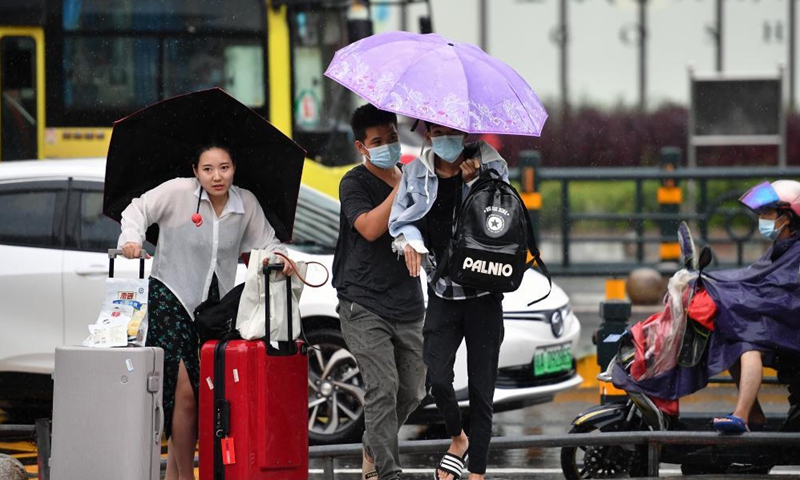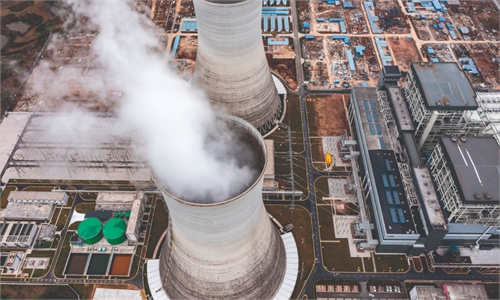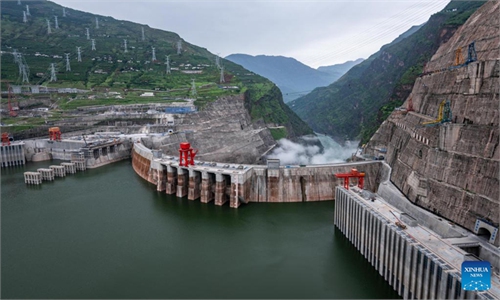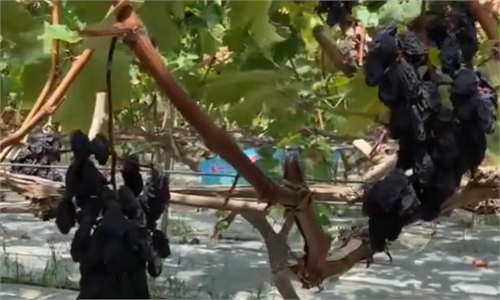Lingering drought brings rising demand for rain bombs to create artificial rainfall

People walk in rain Photo:Xinhua
Affected by continuous high temperatures and little rain this year, many places across China have used rain bombs to create artificial rainfall, bringing sharp demand for the devices.
"Our sales are rising sharply, and supplies are short," Jiangxi Xinyu Guoke Technology Co told share investors on Wednesday.
Jiangxi Xinyu Guoke, a producer of artificial weather influencing equipment and meteorological equipment, including rain-enhancing rockets, said that the company is rushing to produce 20,000 rain bombs to help the country's fight against drought, according to the Securities Times.
Xinyu Guoke was one of the earliest companies engaged in the R&D and production of artificially modified weather rockets. Its 2020 financial report said that it has an annual production capacity of 50,000 rockets for artificial weather modification and rain enhancement, and the company has good relations with nearly 1,000 counties' meteorological departments across China.
Information news portal cls.cn said that since May, the assembly production line of its rain bombs has been running at full capacity, with a daily output of 400 units.
Shaanxi Zhongtian Rocket Technology Co, another manufacturing giant of model rockets and forest fire-fighting bombs, said its production of 100,000 rain bombs was approved by experts of the Ministry of Industry and Information Technology in July.
China is a vast country, with precipitation varying in different places. But on the whole, sales of rain-enhancing rockets have remained stable.
The official WeChat account of China Aerospace Science and Technology Corp said on Tuesday that the Zhongtian Rocket can produce more than 400 rain bombs a day, and the automation rate of the production line has reached more than 60 percent.
In addition, local governments have stepped up purchases and stockpiles of rain bomb products. Northwest China's Xinjiang Uygur Autonomous Region is inviting bids for renting aircraft to carry out artificial water augmentation operations with maximum fee of 1.2 million yuan ($174,810) per month.
Large areas of China have experienced heat waves this year. Southwest China's Chongqing city, for example, is experiencing the most severe sustained hot weather since 1961. Persistent drought and heat waves have caused multiple bushfires in the mountainous areas of Chongqing, according to the municipal publicity department.
China's national observatory on Tuesday renewed an orange alert for drought, the second most severe warning of the country's four-tier weather warning system.
Also on Tuesday, China's national observatory continued to issue a red alert for high temperatures, the most severe warning in its four-tier warning system. It is the 12th consecutive day that the National Meteorological Center has issued a red alert for high temperatures.
On Tuesday, there were still high temperatures of 35-39 C in many parts of the country. The highest temperatures in parts of eastern Sichuan, Chongqing, and central Jiangxi were above 40 C.
China is easily affected by droughts and floods, given its vast territory and the monsoonal climate characteristics, and the demand for artificial rain-enhancing rockets such as rain bombs is increasing.
China has the world's largest artificial weather modification capability, and its technical level is leading the world, Ma Jun, director of the Beijing-based Institute of Public and Environmental Affairs, told the Global Times on Wednesday, explaining that some cities also have a special department to operate it.
It is the right time for artificial rainfall, as the climate in the past few days changed from drought to rain. A typhoon is also active, bringing rainfall to the entire southeastern coast, and the cold air in the north is stronger, Ma said.
But he warned that the control of climate change cannot rely entirely on artificial influences. For example, when artificial precipitation occurs, it will have a more serious impact on some areas that have been short of water for a long time.
Although China has ability, it is necessary to have a clear understanding of climate change. For example, some areas in the Yangtze River valley have not had significant rainfall for more than 70 days and do not have the conditions for artificial rainfall, and the chemical materials of artificial rainfall could impact the environment, Ma noted.



